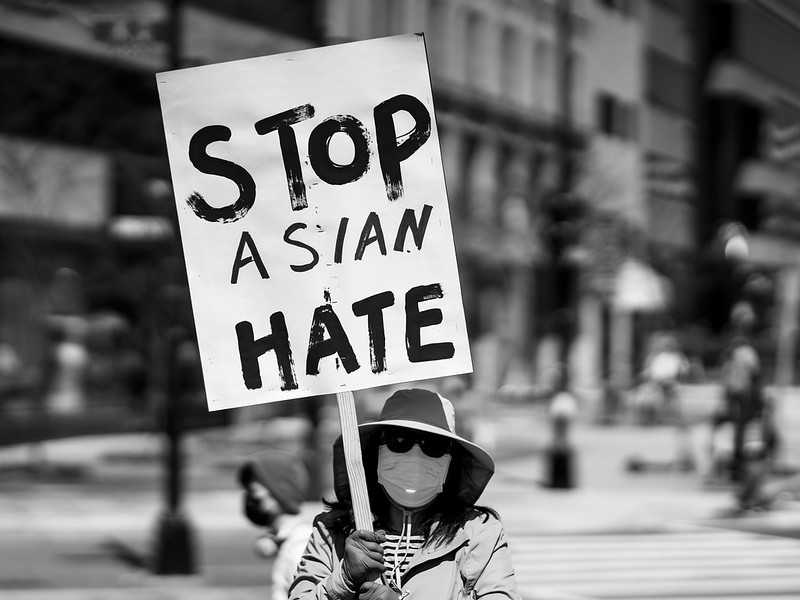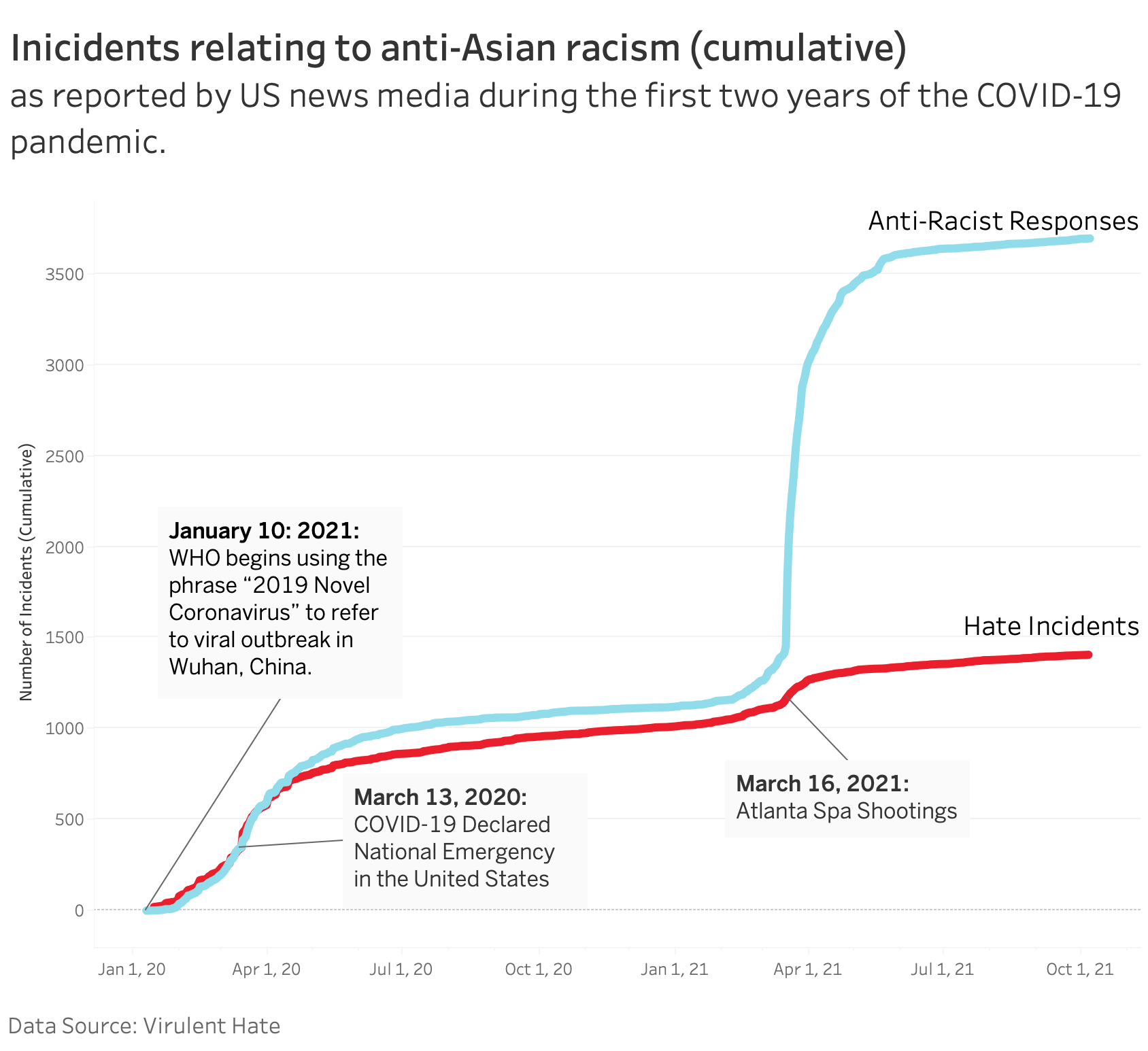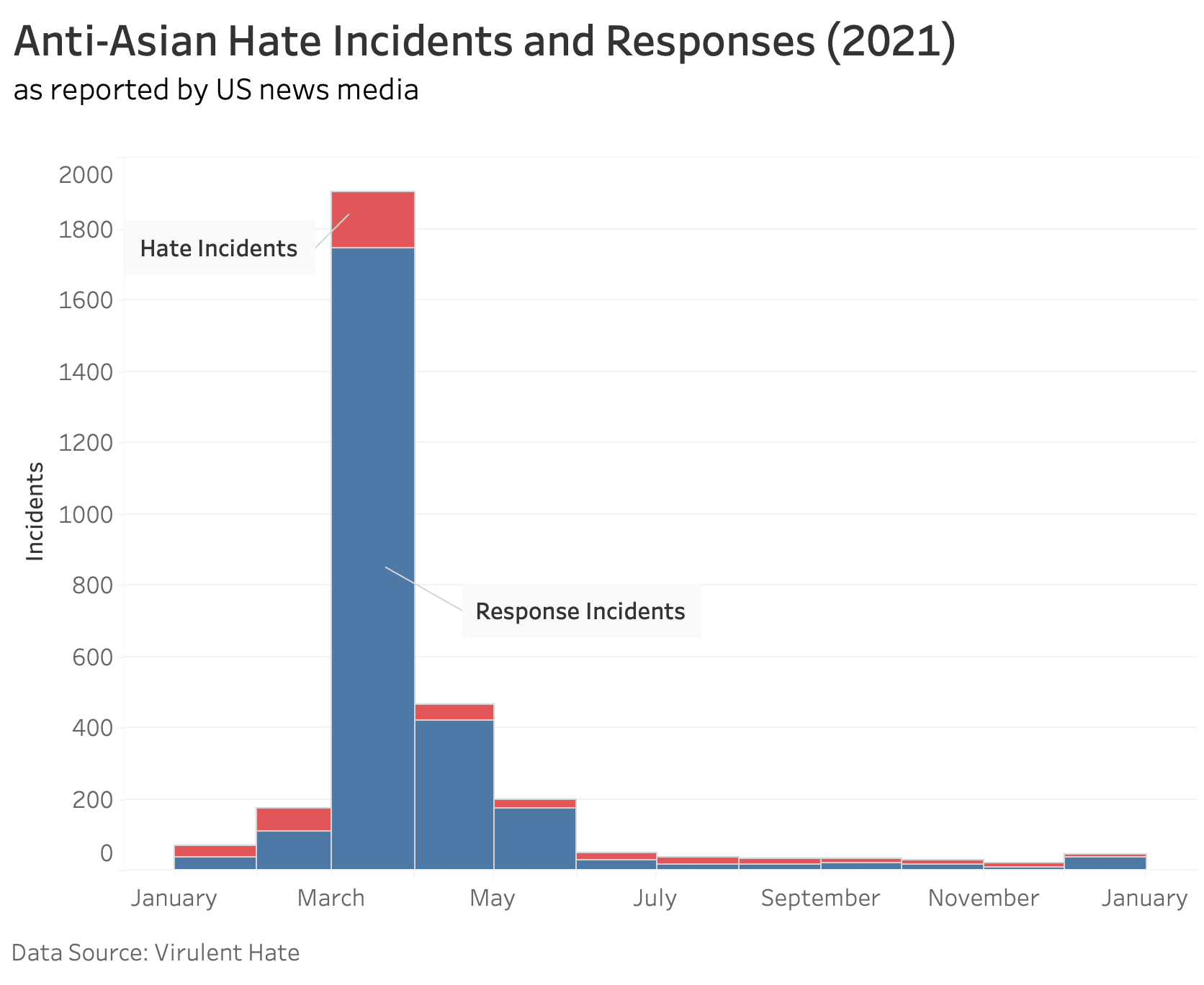Anti-Asian Racism and Anti-Racist Responses in 2021

DC Rally for Collective Safety, March 21, 2021. Photo by Miki Jourdan, licensed under CC BY-NC-ND 2.0.
Among its many devastating effects, the COVID-19 pandemic brought a rise in racism against Asian Americans and Pacific Islander Americans who were scapegoated for the virus. As early as January 2020 – two months before COVID-19 would be declared a global pandemic – Asian American and Pacific Islander (AAPI) activists and groups to began to warn of an alarming rise in harassment and discrimination against AAPI communities.
These calls were all to prescient, as a wave of anti-Asian violence and harassment hit communities across the country during the first months of the pandemic. These effects were often worsened amid increased xenophobia from the Trump administration and social tension during stay at home orders.
While these horrific trends continued throughout the pandemic and beyond, it was not met without resistance. The pandemic was also a moment of intense community organizing from non-profits, religious groups, and public figures – both online and in person. Individuals and groups across the country held events, demanded political action, and sought to change public narratives.
This article will look deeper in the forces shaping this activism, analyzing how hate incidents and responses to those incidents were covered in news media throughout 2021.
During that year, anti-Asian racism reached its pitch in the public eye with the Atlanta Spa shootings, where a gunman targeted two spas and a massage parlor, killing eight people, including six Asian American women. This twin-event of racism and misogyny sparked nationwide protests and resulted in several major political actions across state and federal government.
The data in this article comes from Virulent Hate, a digital humanities project documenting anti-Asian racism and activism during the first two years of the pandemic. Virulent Hate's data is created from publicly reported news articles, documenting individual incidents and how often they were covered in the news. Each incident is categorized and described, allowing us to analyze trends and find connections.
Major News Stories
After a relative plateau in the later half of 2020 of public reports of anti-Asian racism and responses, 2021 began with a string of attacks on elderly Asian Americans in San Francisco and Oakland, California. These concerning incidents led to a surge in local organizing, news coverage, and political action. California passed AB 85, a $1.4 million state bill aiming to combat anti-Asian violence and racism, and multiple resolutions denouncing violence and seeking to prevent future incidents were introduced into the U.S. House and Senate.
Throughout February 2021, several other incidents of verbal harassment, vandalism, and violence made national headlines, including another attack in Oakland, California that left a 75-year-old Chinese man dead.
On March 14, 2021, these reports led Georgia State Senator Michelle Au to urge her colleagues to pay attention to rising anti-Asian violence in a speech on the Georgia Senate floor. Tragically, two days later, Robert Aaron Long murdered eight people, including six Asian American women, during a shooting spree at two spas and a massage parlor around Atlanta.
In the days and weeks following the attacks, the country saw an unprecedented level of anti-racist organizing and protest in outrage at discernible the racial animus in the killings. Up to this point, the number of responses tracked closely to the number of reported hate incidents. However, given the devastation of the events in Atlanta, this dynamic changed. Between March 15 and May 31, 2021, more than 2,200 public responses were tracked by Virulent Hate, significantly outpacing organizing during any other period of the pandemic.

The number of reported response incidents saw an explosive increase after the 2021 Atlanta spa shootings.
This organizing resulted in significant legislation across the country, including the Illinois' Teaching Equitable Asian American Community History (TEAACH) Act and the federal COVID-19 Hate Crimes Act Although it is important to note that there were significant critiques levied against responses that approached anti-Asian racism as a hate crime problem, and centered carceral solutions.
Unfortunately, the Spa Shootings were not the last high profile act of hate in 2021, which also saw the shooting of Sikh workers at a FedEx plant in Indianapolis, IN, and stabbing in San Francisco. This was in addition to the countless other acts of verbal harassment, discrimination, and stigmatization that often goes unreported in national and local news.
Interactive timeline
When did events take place?
As mentioned above, the rate at which incidents of anti-Asian Racism and anti-racist activism took place in 2021 varied dramatically throughout the year.
January and February saw a noticeable uptick in hate incidents, which coincided with increased activism during those moths. Following the Atlanta shootings, the number of responses exploded as the Stop Asian Hate movement coalesced, holding protests across the country. Notably, hate incidents also rose in March. However, given the nature of the data set – incidents covered by public news sources – it is possible that a portion of this measure increase in hate incidents during is due to more attention on the issue rather than real-world changes.

March 2021 saw a dramatic increase of both hate and response incidents as reported by US news media.
Where did events take place?
Both racist incidents and anti-racist responses happened nearly everywhere across the country. Hate incidents occurred in 37 states and the District of Columbia and Response Incidents occurred in 48 states and the District of Columbia.
While there tended to be more incidents in areas with greater population, such as California and New York, it is important to call out that incidents were not limited to areas with high Asian American population.
What Types of Events Occurred?
Harassment Incidents
Anti-Asian harassment took many forms in 2021. Virulent Hate tracked nine main forms of harassment: verbal, physical, vandalism, expectorating (coughing, spitting, or sneezing), robbery, avoidance, denial of service, and signs/visual media/propaganda. Incidents frequently included multiple forms of harassment. Virulent Hate also noted where events took place, and if harassers targeted individuals based on a perceived stereotype or identity.
The following network visualization shows the frequency of identified characteristics and how often certain characteristics occurred together.
The most frequent forms of harassment reported in news media were verbal and physical harassment. As seen in the network, these incidents frequently happened on public streets and sidewalks, in businesses, or on public transit. This result is not altogether surprising, as COVID-19 reduced the amount of time individuals were spending in indoor spaces except for essential activities.
In the chart, we can also see that harassers repeatedly drew on false stereotypes of Asian Americans as “perpetual foreigners” and more likely to be infected with COVID-19. These trends mirror stigmatizing language used by Donald Trump and other White House officials at the time.
Response Incidents
Activists, community groups, non-profits, politicians, celebrities, religious groups, universities, schools, businesses, workers, and individuals all sought to resist the rise in anti-Asian racism in different ways.
These responses included holding community events, releasing formal statements, mutual aid and resources creation, educational events, artistic creations, letters, personal testimony, petitions, and forming cross-racial coalitions.
Two of the most frequent forms of response were holding community events (including protests) and releasing formal statements. The former was more likely to include activists and Asian American organizations, while the latter was often taken by politicians, universities, and celebrities. There were also many instances of these groups working together, including to produce resources, educational events, art, and political resolutions.
Because of COVID-19 safety measures, more than half of response incidents took place online, via social media, Zoom meetings, and asynchronously. When response events happened in person, they often occurred at universities, government buildings, or public streets and parks.
Future directions
While this article focused on the characteristics of events documented by Virulent Hate, there is still another side of the dataset that is unexplored: how media covered these events.
In the future, I hope to analyze the characteristics that drove news coverage in 2020 and 2021. Were particular types of incidents, such as physical and verbal harassment, more likely to be covered multiple times or by news outlets beyond the state where the event occurred? How did these trends change throughout the pandemic? Can we use news coverage statistics to identify particularly salient stories at any given point?
This analysis will be an important part of continuing to understand this dataset, as the bias of news reporters is baked into all the data. Until we have a better understanding of those trends, it can be hard to pull apart real-world trends from reporting trends.